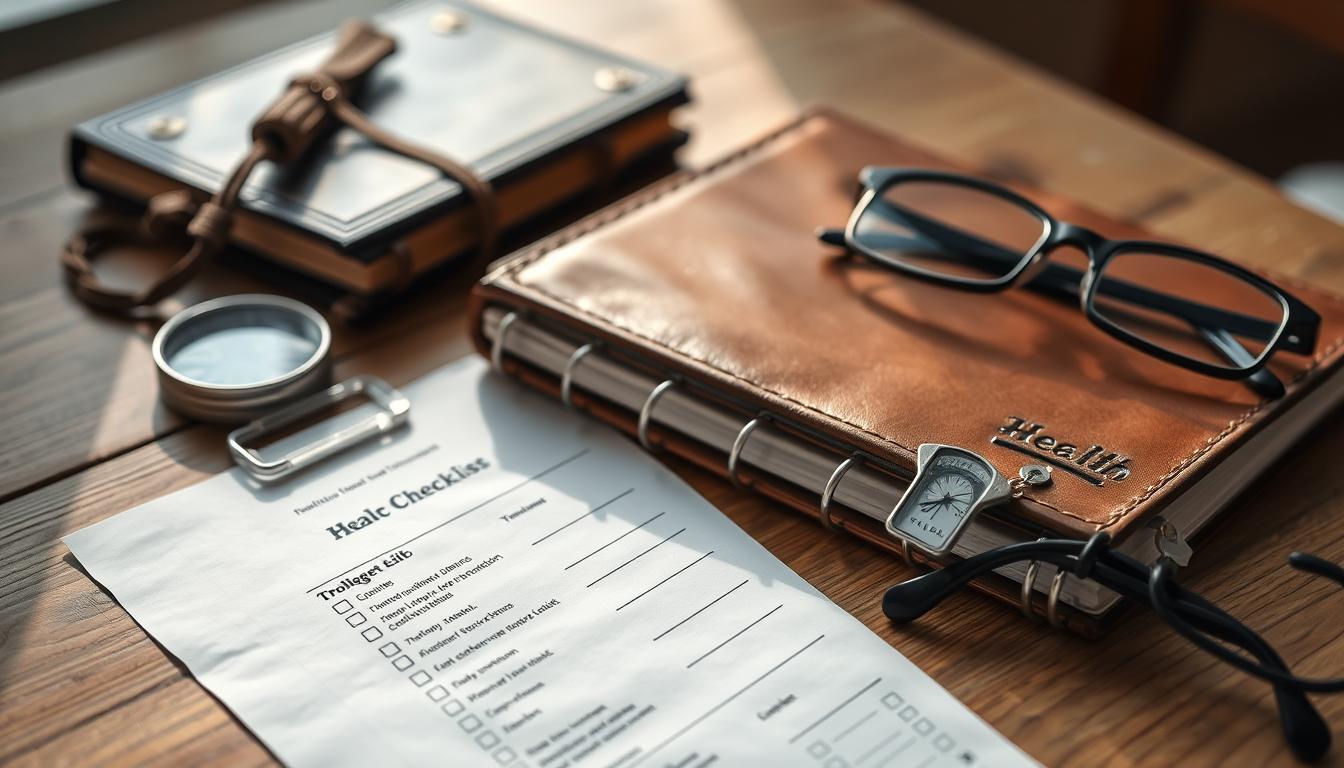Packing your bags for an adventure? Don’t forget the most important item—your personalized health plan. Whether you’re exploring tropical forests or bustling cities, a well-organized guide ensures you’re ready for anything. This isn’t just about bandaids and bug spray. It’s about peace of mind, knowing your essentials—from prescriptions to emergency contacts—are sorted before you step out the door.
We’ve all felt that pre-trip stress: “Did I refill my medication?” or “What if I lose my insurance card?” That’s why we designed this system to cover every detail. First-time explorers and seasoned globetrotters alike benefit from clear steps to verify vaccinations, pack a medical kit, and research local clinics. Destination-specific risks? We’ll help you navigate them.
Your safety shouldn’t rely on luck. A structured approach keeps you in control, whether handling minor scrapes or unexpected emergencies. No more scrambling for phone numbers or guessing dosage instructions. Just confidence, knowing you’ve planned wisely.
Ready to explore freely? Let’s build your safety net together—so you can focus on the journey ahead.
Pre-Trip Preparations and Destination Research
Research is your first step to a smooth journey. Start by gathering destination-specific information from trusted sources. Government websites and embassy portals offer real-time updates on safety alerts, entry rules, and cultural norms. Never assume requirements stay the same—double-check everything.
Review Travel Advisories and Local Requirements
Visit the U.S. Department of State’s website for current advisories. Look for health warnings, political unrest, or natural disasters in your destination. Bookmark your nearest embassy or consulate page—they provide emergency contacts and local clinic lists. Enroll in STEP to get instant alerts about sudden changes.
Understand Entry, Exit, and Visa Necessities
Check your passport’s expiration date. Many countries require six-month validity beyond your trip dates. Apply for visas early—some take weeks to process. If driving abroad, study local road signs and license requirements. Confused? Embassy staff can clarify regulations.
Pro tip: Set Google alerts for your destination. This catches last-minute updates like strikes or weather shifts. A little prep now saves stress later.
Travel Documents and Prescription Management
Your journey begins long before takeoff. Securing paperwork and medications isn’t glamorous, but it’s your safety net abroad. Let’s simplify the process so you’re covered from departure to return.
Organize Essential Travel Documents
Start by gathering your passport, visa, and IDs. Make two physical copies—one for your luggage and another left with family. Save digital versions in a password-protected folder or cloud service. If sickness strikes, having quick access to health information speeds up medical care.
Manage Prescriptions and Medication Needs
Contact your provider 4-6 weeks before leaving. Confirm you have enough prescriptions for your trip plus 7 extra days. Ask for a doctor’s signed letter listing generic drug names—this avoids customs delays. Keep medications in original bottles with labels intact.
Double-check your health insurance covers international services. Save emergency contacts in your phone and on a card in your wallet. With these steps, you’ll handle surprises calmly, knowing support is just a call away.
Essential Travel Health Checklist Items
Smart explorers know preparation beats panic when it comes to staying well abroad. Your medical supplies aren’t just bandaids and aspirin—they’re lifesaving tools tailored to your needs. Let’s build a kit that adapts to jungles, cities, or deserts.

Compile a Personal Medical Kit
Start with the basics: pain relievers, antiseptic wipes, and adhesive bandages. Add prescription medications in original bottles—never mix tablets in pill organizers. Customize based on your destination:
| Item | Purpose | Quantity |
|---|---|---|
| Ibuprofen | Pain/fever relief | 20 tablets |
| Antihistamines | Allergy attacks | 10 doses |
| Electrolyte packets | Dehydration | 5 single-use |
| Antiseptic cream | Wound care | 1 tube |
Remote areas demand extra options. Include water purification tablets and a compact splint if hiking. Ask your doctor about antibiotics for stomach issues—some require prescriptions.
Ensure Documentation for Medications and Prescriptions
Customs agents need clear proof your medications are legal. Keep a signed letter from your doctor listing generic drug names and dosages. Photograph prescriptions and save them offline.
Why does this matter? Imagine needing emergency care in a foreign hospital. With proper paperwork, doctors quickly verify your medications. No delays. No guesswork. Just efficient treatment.
Pro tip: Pack a small card with emergency contacts and blood type. Stick it behind your ID. When seconds count, having details at hand makes all the difference.
Building a Practical Travel Health Kit
A well-stocked medical kit is your silent travel companion. It adapts to jungles, cities, or deserts—ready for scrapes, sunburns, or surprises. Let’s create a system that blends emergency readiness with daily care, tailored to your destination’s unique risks.
Include First Aid and Emergency Supplies
Start with a waterproof pouch for essentials. Bandages, antiseptic wipes, and hydrocortisone cream handle minor injuries. Add tweezers for splinters and antihistamines for allergic reactions. Insect bite relief gels soothe itching fast.
Remote areas demand extras: a compact splint, sterile gauze, and a whistle for emergencies. Travel insurance matters here—policies covering medical evacuations save thousands if accidents occur. Keep your provider’s contact info in your phone and wallet.
Pack Skin Protection and Hygiene Essentials
Sunburns ruin trips. Use broad-spectrum SPF 30+ sunscreen and reapply every two hours. Pair it with SPF lip balm and UV-blocking hats. Lightweight, long-sleeved shirts shield against bugs and sun alike.
Hand sanitizer and biodegradable wipes keep germs at bay. Add water purification tablets if local supplies are questionable. A foldable silicone bottle ensures clean hydration anywhere.
| Category | Must-Haves | Pro Tip |
|---|---|---|
| First Aid | Bandages, antiseptic, pain relievers | Replace expired items yearly |
| Skin Care | Sunscreen, aloe vera, insect repellent | SPF 30+ blocks 97% UV rays |
| Safety | Water tablets, emergency blanket | Test tablets before departure |
Double-check expiration dates monthly. Rotate supplies seasonally—heat degrades medications. With this approach, you’ll handle adventures calmly, knowing safety essentials are within reach.
Emergency Preparedness and Local Medical Resources
Unexpected events don’t have to derail your adventures. A solid plan turns chaos into manageable steps. Start by connecting with resources that keep you informed and protected—wherever you roam.
Enroll in STEP for Critical Alerts
The Smart Traveler Enrollment Program (STEP) is your lifeline abroad. This free service sends real-time updates about security risks, health advisories, and extreme weather in your destination countries. We recommend enrolling during trip planning—it takes five minutes but offers peace of mind for months.
Here’s why it matters: If protests erupt or hurricanes approach, STEP alerts help you adjust plans fast. Embassies use your enrollment details to locate you during crises. Bonus? Family can reach you through embassy contacts if phones fail.
Next, map medical facilities. Search embassy websites for vetted clinics and hospitals. Apps like IAMAT list English-speaking doctors in 130+ countries. Save addresses offline—you’ll thank yourself later.
Double-check your insurance coverage includes overseas care. Print policy numbers and emergency hotlines. Slip a copy into your passport holder. Pro tip: Share your itinerary with two trusted contacts. They’ll know where to send help if needed.
Smart preparation isn’t about fearing the worst—it’s about owning your safety. With STEP alerts and local clinic info, you’ll navigate surprises like a pro. Adventure confidently, knowing support systems are in place.
Conclusion
Your adventure deserves more than just excitement—it needs a safety net. By following these steps, you’ve built a shield against the unexpected. From verifying documents to packing medical essentials, every choice prioritizes your travel health and well-being.
Careful preparation isn’t about fear—it’s freedom. Whether you’re a first-time traveler or seasoned globetrotter, reviewing each safety measure ensures you’re ready. Double-check prescriptions and confirm insurance coverage. These small acts let you focus on experiences, not emergencies.
Even if your trip may need destination-specific additions, this guide offers a trusted foundation. Personalize your approach—swap supplies based on climate or activities. Our final tip? Share your itinerary with someone you trust.
Now breathe deep and step forward confidently. The world awaits—armed with knowledge and care, you’re prepared to embrace it fully. Safe journeys, and may every mile bring joy.


